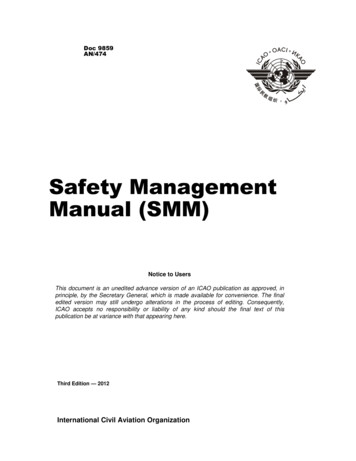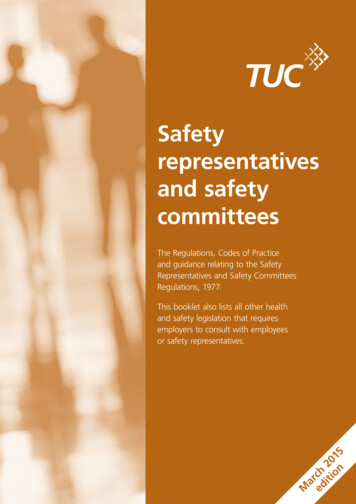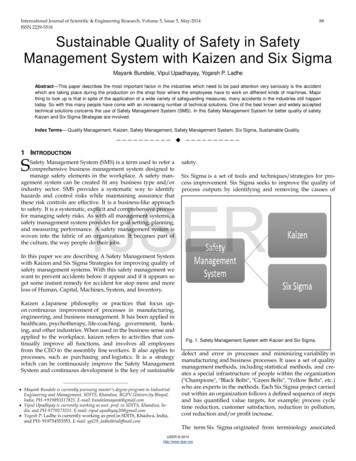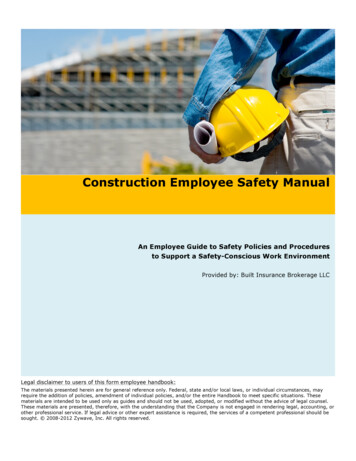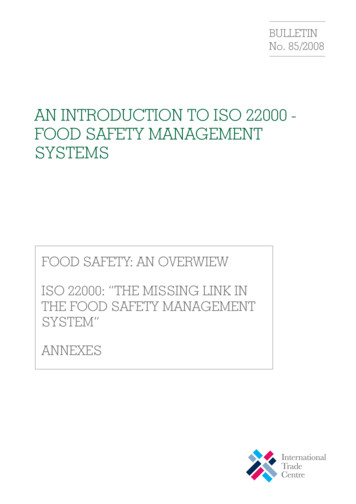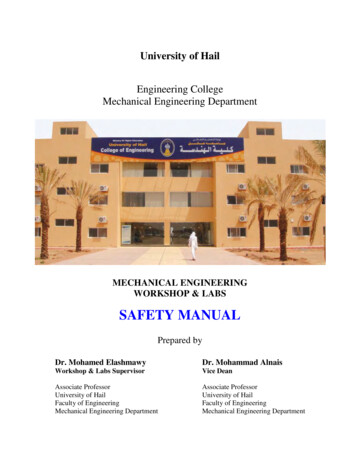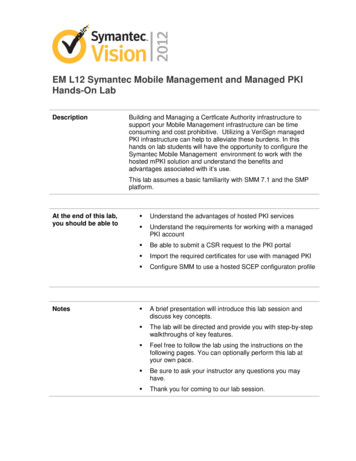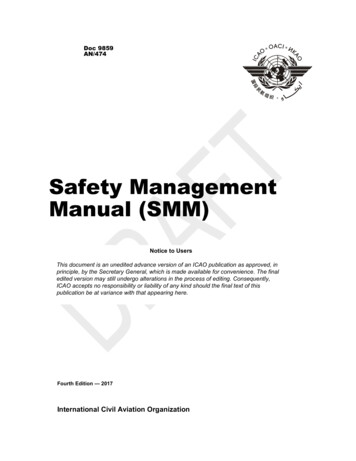
Transcription
Doc 9859AN/474Safety ManagementManual (SMM)Notice to UsersThis document is an unedited advance version of an ICAO publication as approved, inprinciple, by the Secretary General, which is made available for convenience. The finaledited version may still undergo alterations in the process of editing. Consequently,ICAO accepts no responsibility or liability of any kind should the final text of thispublication be at variance with that appearing here.Fourth Edition — 2017International Civil Aviation Organization
Fourth edition 2017 ICAO 2017All rights reserved. No part of this publication may be reproduced, stored in aretrieval system or transmitted in any form or by any means, without priorpermission in writing from the International Civil Aviation Organization.
Safety Management Manual (SMM)AMENDMENTSAmendments are announced in the supplements to the Catalogue of ICAO Publications; the Catalogue and itssupplements are available on the ICAO website at www.icao.int. The space below is provided to keep a record ofsuch amendments.AMENDMENTSNo.DateCORRIGENDAEntered byNo.DateEntered by
ICAO Doc 9859SAFETY MANAGEMENT MANUALEdition 4SAFETY MANAGEMENT MANUALEXECUTIVE SUMMARYSummary of SMM Ed4 content to be completed after the Peer ReviewXxxxLast Saved: 05/06/2017 17:31:00Page 3 of 149Draft version: V1.0
ICAO Doc 9859SAFETY MANAGEMENT MANUALEdition 4FOREWORDThe Standards and Recommended Practices (SARPs) in Annex 19 - Safety Management and the guidance providedin this ICAO Safety Management Manual (SMM) (Doc 9859) are intended to support States in fulfilling theirobligations regarding the Convention through the management of aviation safety risks. Annex 19 and this manualsupport the continued evolution of a proactive strategy to improve safety performance. The foundation of thisproactive safety strategy is based on the implementation of State Safety Programmes (SSP), which includes ensuringservice providers to implement Safety Management Systems (SMS), to systematically address safety risks. Thisfourth edition of the SMM supersedes the third edition, published in May 2013, in its entirety.Purpose and objectivesThe purpose of the SMM is to provide States and service providers with guidance when implementing or maintainingsafety management in their organisation in accordance with the SARPs in ICAO Annex 19. The objectives of thismanual are to assist States to: transition towards a performance-based approach to safety; put in place mechanisms for the protection of safety information; and achieve the objectives outlined in the GASP.Indirectly the manual should also support service providers in their transition towards a performance-based approachto safety while delivering their product and/or service.Note 1.—persons.In this manual, the use of the male gender should be understood to include both male and femaleScope and exclusionsThe scope of this 4th edition of the SMM includes: Safety management guidance for all States, regardless of size or complexity; Safety management guidance for service providers required to implement SMS in Annex 19regardless of size or complexity; and Safety management guiding principles that may be applied to aviation activities outside of theapplicability of Annex 19.The following are excluded from the scope the 4th edition of the SMM: Guidance to support sector-specific safety management SARPs found outside of Annex 19(e.g. flight data analysis programmes); Guidance on the conduct of independent State accident and serious incident investigations.Intended audiencesThe intended audiences for the SMM are: States. In particular: Senior managers with a role in aviation safety, safety managers, safetyauditors, safety analysts from Civil Aviation Authorities (CAA) and Departments/Ministries ofTransport; and Service providers. In particular, accountable executives, safety managers, internal safetyauditors, safety investigators and safety analysts.Last Saved: 05/06/2017 17:31:00Page 4 of 149Draft version: V1.0
ICAO Doc 9859SAFETY MANAGEMENT MANUALEdition 4Manual StructureThe SMM is divided into three parts. Each part is divided into chapters. The manual structure intends to progressivelybuild the reader’s understanding of safety management. From background information, to key underpinning conceptsto guidance on safety management implementation. Part I – Introduction and background: Introduces the reader to the concept of safetymanagement and explains the background, benefits and history of ICAO safety managementdevelopment. This part provides the reader with fundamental information underpinning safetymanagement practice, such as: accident causation, practical drift and safety risk management.Safety culture is covered in detail in a separate chapter because of its importance as an enablerto effective safety management implementation. Part II – Developing safety intelligence: Part II comprises three important and interrelatedtopics about safety data and safety information. Part II begins with an important chapter aboutprotection of safety data, safety information and related sources which is important to ensure itscontinued availability. A chapter follows this on safety performance management that provides thedirection for safety management activities. Part II culminates by introducing and explaining datadriven decision-making, and how this concept is leveraging the data collected to empoweraviation leaders. Part III – Effective safety management: Provides specific guidance on implementing safetymanagement on two levels:ofor States to fulfil their safety management obligations through the implementation of aState safety programme (SSP); andorelated to the implementation of SMS by service providers. States should use theguidance on the process for accepting the SMS of a service provider found in bothchapters in Part III.These two levels of safety management interact to drive the continuous improvement of safetyperformance for the aviation system of a State that consequently contributes to the overallimprovement of global aviation safety.Safety Management Implementation WebsiteThis 4th edition of the SMM is complemented by the ICAO Safety Management website(http://www.icao.int/XXXXXXXXX). The website was established to address a recommendation stemming from thesecond High-level Safety Conference held in 2015 requesting ICAO to establish a mechanism for the sharing of bestpractices related to safety management. The website includes some of the examples and tools from the third editionof the SMM with additional practical examples, tools, and supporting educational material to be collected, reviewedand posted on an ongoing basis. A summary of the major changes between the fourth edition and the third edition ofthe SMM is also posted on the website.Comments on this manual, particularly with regard to its application and usefulness, would be appreciated from allStates, safety oversight audit missions and ICAO technical cooperation field missions. These will be taken intoconsideration in the preparation of subsequent editions. Comments should be addressed to:The Secretary GeneralInternational Civil Aviation Organization999 Robert-Bourassa BoulevardMontréal, Quebec H3C 5H7CanadaLast Saved: 05/06/2017 17:31:00Page 5 of 149Draft version: V1.0
ICAO Doc 9859SAFETY MANAGEMENT MANUALEdition 4Intentionally Left BlankLast Saved: 05/06/2017 17:31:00Page 6 of 149Draft version: V1.0
ICAO Doc 9859SAFETY MANAGEMENT MANUALEdition 4TABLE OF CONTENTSPageEXECUTIVE SUMMARYForewordAcronyms and abbreviationsRelated ICAO publicationsGlossaryPART I. INTRODUCTION AND BACKGROUND349111416Chapter 1. Introduction1.1What is safety management?1.2Annex 19 – Safety Management1.3Safety management applicability1.4Implementing safety management1.5Integrated risk management17Chapter 2. Safety management fundamentals2.1Concept of safety and its evolution2.2Accident causation2.3Management dilemma2.4Safety risk management26Chapter 3. Safety culture3.1Introduction3.2Safety culture maturity3.3Promoting a positive safety culture3.4Safety culture and national culture3.5Safety culture and safety reporting3.6Promotion and assessment of a positive safety culture45PART II. DEVELOPING SAFETY INTELLIGENCE52Chapter 1. Protection of safety data, safety information and related sources1.1Objectives and contents1.2Fundamental principles1.3Scope of protection1.4Level of protection1.5Principle of protection1.6Principle of exception1.7Public disclosure1.8Protection of recorded data1.9Safety information sharing and exchange53Chapter 2. Safety performance management2.1Introduction2.2Phases of safety performance management2.3Safety objectives2.4Safety performance indicators2.5Safety performance targets69Chapter 3. Data-driven decision making3.1Introduction78Last Saved: 05/06/2017 17:31:00Page 7 of 149Draft version: V1.0
ICAO Doc 9859SAFETY MANAGEMENT MANUAL3.2Definitions of data and information3.3Data-driven decision making3.4Advantages of data-driven decision making3.5Common challenges3.6The data-driven decision making process3.7Data management3.8Safety information sharing and exchangePART III. EFFECTIVE SAFETY MANAGEMENTChapter 1. State safety management1.1Introduction1.2State safety programme1.3Component 1: State safety policy, objectives and resources1.4Component 2: State safety risk management1.5Component 3: State safety assurance1.6Component 4: State safety promotion1.7SSP ImplementationChapter 2. Safety management systems2.1Introduction2.2Component 1: Safety policy and objectives2.3Component 2: Safety risk management2.4Component 3: Safety assurance2.5Component 4: Safety promotion2.6Implementation planningEdition 48990118Last Saved: 05/06/2017 17:31:00Page 8 of 149Draft version: V1.0
ICAO Doc 9859SAFETY MANAGEMENT MANUALEdition 4ACRONYMS AND nt/incident data reportingAccident investigation boardAcceptable level of safety performanceApproved maintenance organizationAir navigation serviceAir operator certificateAir traffic controlAir traffic managementAir traffic service(s)CAACBACEOCirCMACNSCRMCVRCivil aviation authorityCost-benefit analysisChief executive officerCircularContinuous monitoring approachCommunications, navigation and surveillanceCrew resource managementCockpit voice recorderD&MDOADocDesign and manufacturingDesign organization approvalDocumentECCAIRSEMSERPEuropean Coordination Centre for Accident and Incident Reporting SystemsEnvironmental management systemEmergency response planFDRFMSFRMSFlight data recorderFinancial management systemFatigue risk management systemsHFHIRAHIRMHuman factorsHazard identification and risk assessmentHazard identification and risk mitigationICAOISOiSTARSInternational Civil Aviation OrganizationInternational Organization for StandardizationIntegrated Safety Trend Analysis and Reporting SystemLEILOSLOSALack of effective implementationLoss of separationLine operations safety auditMDRMORMandatory defect reportMandatory occurrence reportN/ANot applicableOEMOriginal equipment manufacturerLast Saved: 05/06/2017 17:31:00Page 9 of 149Draft version: V1.0
ICAO Doc 9859SAFETY MANAGEMENT MANUALOHSMSOPSORPOSCOSHEOccupational health and safety management systemOperationsOrganization risk profileOrganization safety cultureOccupational safety, health and environmentPCPOAPIRGPreventive controlProduction organization approvalPlanning and Implementation Regional GroupQAQCQMQMSQuality assuranceQuality controlQuality managementQuality management systemRAIORASGRMRSOORegional accident and incident investigation organizationRegional Aviation Safety GroupRecovery measureRegional safety oversight SPISRBSRCSRMSSOSSPSTDEVPSafety action groupStandards and Recommended PracticesStandard deviationSafety data collection and processing systemSecurity management systemSoftware/hardware/environment/livewareSafety managementSafety management manualSafety Management PanelSafety management system(s)Standard operating proceduresSafety performance indicatorSafety review boardSafety review committeeSafety risk managementState safety oversightState safety programmePopulation standard deviationTBDTORTo be determinedTerms of referenceUCUEUSOAPUltimate consequenceUnsafe eventUniversal Safety Oversight Audit ProgrammeLast Saved: 05/06/2017 17:31:00Page 10 of 149Edition 4Draft version: V1.0
ICAO Doc 9859SAFETY MANAGEMENT MANUALEdition 4RELATED ICAO PUBLICATIONSPROCEDURES FOR AIR NAVIGATION SERVICES (PANS)Aerodromes (Doc 9981)Aircraft Operations ( Doc 8168)Air Traffic Management (Doc 4444)Training (9868)CIRCULARSA Unified Framework for Collision Risk Modelling in Support of the Manual on Airspace Planning Methodology for theDetermination of Separation Minima (Doc 9689) (Cir 319)Assessment, Measurement and Reporting of Runway Surface Conditions (Cir 329)Assessment of ADS-B and Multilateration Surveillance to Support Air Traffic Services and Guidelines forImplementation (Cir 326)Civil Military Cooperation in Air Traffic Management (Cir 330)Hazards at Aircraft Accident Sites (Cir 315)Operation of New Larger Aeroplanes at Existing Aerodromes (Cir 305)Training Guidelines for Aircraft Accident Investigators (Cir 298)Unmanned Aircraft Systems (UAS) (Cir 328)GUIDANCE MATERIALAdvanced Surface Movement Guidance and Control Systems (A-SMGCS) Manual (Doc 9830)Airport Services Manual (Doc 9137)Part 1 — Rescue and Fire FightingPart 5 — Removal of Disabled AircraftPart 7 — Airport Emergency PlanningAirworthiness Manual (Doc 9760)Fatigue Management Guide for Airline OperatorsFatigue Management Guide for Air Traffic Services ProvidersFatigue Management Guide for General Aviation Operators of Large and Turbojet AeroplanesGlobal Air Navigation Plan (Doc 9750)Last Saved: 05/06/2017 17:31:00Page 11 of 149Draft version: V1.0
ICAO Doc 9859SAFETY MANAGEMENT MANUALEdition 4Global Aviation Safety Plan (GASP) (Doc 10007)Global Air Traffic Management Operational Concept (Doc 9854)Human Factors Guidelines for Air Traffic Management (ATM) Systems (Doc 9758)Human Factors Guidelines for Aircraft Maintenance Manual (Doc 9824)Human Factors Guidelines for Safety Audits Manual (Doc 9806)Human Factors Training Manual (Doc 9683)Line Operations Safety Audit (LOSA) (Doc 9803)Manual Concerning Interception of Civil Aircraft (Doc 9433)Manual Concerning Safety Measures Relating to Military Activities Potentially Hazardous to Civil Aircraft Operations(Doc 9554)Manual for the Oversight of Fatigue Management Approaches (Doc 9966)Manual of Aircraft Accident and Incident Investigation (Doc 9756)Part I — Organization and PlanningPart II — Procedures and ChecklistsPart III — InvestigationPart IV — ReportingManual of Aircraft Ground De-icing/Anti-icing Operations (Doc 9640)Manual of All-Weather Operations (Doc 9365)Manual of Civil Aviation Medicine (Doc 8984)Manual of Procedures for Operations Inspection, Certification and Continued Surveillance (Doc 8335)Manual of Radiotelephony (Doc 9432)Manual of Surface Movement Guidance and Control Systems (SMGCS) (Doc 9476)Manual on Air Traffic Management System Requirements (Doc 9882)Manual on Airspace Planning Methodology for the Determination of Separation Minima (Doc 9689)Manual on Certification of Aerodromes (Doc 9774)Manual on Flight Data Analysis Programmes (FDAP) (Doc 10000)Manual on Global Performance of the Air Navigation System (Doc 9883)Manual on Implementation of a 300 m (1 000 ft) Vertical Separation Minimum Between FL 290 and FL 410 Inclusive(Doc 9574)Last Saved: 05/06/2017 17:31:00Page 12 of 149Draft version: V1.0
ICAO Doc 9859SAFETY MANAGEMENT MANUALEdition 4Manual on Monitoring the Application of Performance-Based Horizontal Separation Minima (Doc 10063)Manual on Regional Accident and Incident Investigation Organization (Doc 9946)Manual on Remotely Piloted Aircraft Systems (RPAS) (Doc 10019)Performance-based Communication and Surveillance (PBCS) Manual (Doc 9869)Manual on Simultaneous Operations on Parallel or Near-Parallel Instrument Runways (SOIR) (Doc 9643)Manual on the Investigation of Cabin Safety Aspects in Accidents and Incidents (Doc 10062)Manual on the Prevention of Runway Incursions (Doc 9870)Manual on the Protection of Safety Information (Doc 10053)Part I — Protection of Accident and Incident Investigation RecordsManual on the Quality Management System for the Provision of Meteorological Service for International AirNavigation (Doc 9873)Normal Operations Safety Survey (NOSS) Manual (Doc 9910)Performance-based Navigation (PBN) Manual (Doc 9613)Performance-Based Navigation (PBN) Operational Approval Manual (Doc 9997)Safety Oversight Manual (Doc 9734)Part A – The Establishment and Management of a State’s Safety Oversight SystemPart B – The Establishment and Management of a Regional Safety Oversight OrganizationUniversal Safety Oversight Audit Programme Continuous Monitoring Manual (Doc 9735)Manual on the Competencies of Civil Aviation Safety Inspectors (Doc 10070)Last Saved: 05/06/2017 17:31:00Page 13 of 149Draft version: V1.0
ICAO Doc 9859SAFETY MANAGEMENT MANUALEdition 4GLOSSARYAcceptable level of safety performance (ALoSP). The minimum level of safety performance of civil aviation in aState, as defined in its State safety programme, expressed in terms of safety performance targets and safetyperformance indicators.Note.— An acceptable level of safety performance for the State can be demonstrated through the implementationand maintenance of the SSP as well as safety performance indicators and safety performance targets showing thatsafety is effectively managed, built on the foundation of implementation of existing safety-related SARPs.Accountable executive. A single, identifiable person having responsibility for the effective and efficient performanceof the service provider’s SMS.Alert. An established level or criteria value that serves as the primary trigger for an evaluation, adjustment orremedial action related to the particular indicator.Change management. A formal process to manage changes within an organization in a systematic manner, so thatchanges which may impact identified hazards and risk mitigation strategies are accounted for, before theimplementation of such changes.Defences. Specific mitigating actions, preventive controls or recovery measures put in place to prevent therealization of a hazard or its escalation into an undesirable consequence.Errors. An action or inaction by an operational person that leads to deviations from organizational or the operationalperson’s intentions or expectations.Hazard. A condition or an object with the potential to cause or contribute to an aircraft incident or accident.High-consequence indicators. Safety performance indicators pertaining to the monitoring and measurement ofhigh-consequence occurrences, such as accidents or serious incidents. High-consequence indicators are sometimesreferred to as reactive indicators.Lower-consequence indicators. Safety performance indicators pertaining to the monitoring and measurement oflower-consequence occurrences, events or activities such as incidents, non-conformance findings or deviations.Lower-consequence indicators are sometimes referred to as proactive indicators.Risk mitigation. The process of incorporating defences or preventive controls to lower the severity and/or likelihoodof a hazard’s projected consequence.Safety. The state in which risks associated with aviation activities, related to, or in direct support of the operation ofaircraft, are reduced and controlled to an acceptable level.Safety assessment. A term used in other ICAO documents to refer to a hazard identification and safety riskmitigation process.Safety data. A defined set of facts or set of safety values collected from various aviation-related sources, which isused to maintain or improve safety.Note.— Such safety data is collected from proactive or reactive safety-related activities, including but not limited to:a) accident or incident investigations;b) safety reporting;Last Saved: 05/06/2017 17:31:00Page 14 of 149Draft version: V1.0
ICAO Doc 9859SAFETY MANAGEMENT MANUALEdition 4c) continuing airworthiness reporting;d) operational performance monitoring;e) inspections, audits, surveys; orf) safety studies and reviews.Safety information. Safety data processed, organized or analysed in a given context so as to make it useful forsafety management purposes.Safety objective. A brief, high-level statement of safety achievement or desired outcome to be accomplished by theState safety programme or service provider’s safety management systems.Note 1.— Safety objectives are developed from the safety risk picture of the State and should be taken intoconsideration during subsequent development of the ALoSP indicators and targets.Note 2.— Safety objectives are developed by the Service provider to reflect the organization’s commitment to safetyand form one basis for the development of safety performance indicators and safety performance targets.Safety oversight. A function performed by a State to ensure that individuals and organizations performing anaviation activity comply with safety-related national laws and regulations.Safety management system. A systematic approach to managing safety, including the necessary organizationalstructures, accountability, responsibilities, policies and procedures.Safety performance. A State’s or service provider s safety achievement as defined by its safety performance targetsand safety performance indicators.Safety performance indicator. A data-based parameter used for monitoring and assessing safety performance.Safety performance target. The State or service provider’s planned or intended target for a safety performanceindicator over a given period that aligns with the safety objectives.Safety risk. The predicted probability and severity of the consequences or outcomes of a hazard.Service provider. Any organization providing aviation products and/or services. The term thus encompassesapproved training organizations that are exposed to safety risks during the provision of their services, aircraftoperators, approved maintenance organizations, organizations responsible for type design and / or manufacture ofaircraft, engines or propellers, air traffic service providers and certified aerodromes.State safety programme. An integrated set of regulations and activities aimed at improving safety.Surveillance. The State activities through which the State proactively verifies through inspections and audits thataviation licence, certificate, authorization or approval holders continue to meet the established requirements andfunction at the level of competency and safety required by the State.Last Saved: 05/06/2017 17:31:00Page 15 of 149Draft version: V1.0
ICAO Doc 9859SAFETY MANAGEMENT MANUALPart IPart IINTRODUCTION AND BACKGROUNDLast Saved: 05/06/2017 17:31:00Page 16 of 149Draft version: V1.0
ICAO Doc 9859SAFETY MANAGEMENT MANUAL1.Part I - Chapter 1Chapter INTRODUCTION1.1WHAT IS SAFETY MANAGEMENT?Introduction to safety management1.1.11.1.1.1Safety management seeks to proactively mitigate safety risks before they result in aviation accidentsand incidents. Safety management enables States to manage their safety activities in a more disciplined and focusedmanner. When a State and its aviation industry have a clear understanding of their role and contribution to safeoperations, it enables them to prioritise safety risks and more effectively manage their resources for optimal aviationsafety benefit.1.1.1.2The foundation of safety management is the implementation of a State safety programme (SSP) byStates and safety management systems (SMS) by service providers. Each State’s SSP combines with the benefits ofeach applicable service provider’s SMS to synergistically and systematically address safety risks, improve the safetyperformance of each service provider, and consequently, the safety performance of the State.1.1.2State safety programmesA State safety programme is defined in Annex 19 as “an integrated set of regulations and activities aimed atimproving safety.” The SSP is established and maintained by States as a structured approach to assist in managingaviation safety risks.1.1.3Safety management systemsA safety management system is defined in Annex 19 as “. A systematic approach to managing safety, including thenecessary organizational structures, accountability, responsibilities, policies and procedures. An SMS is establishedand maintained by each service provider and operator identified in Chapter 3 of Annex 19 (see para 1.4 of this Part,for details on SMS applicability) to continuously improve safety performance by identifying hazards, collecting andanalysing data and continuously assessing safety risks.1.1.4Benefits of safety managementBelow are listed some of the many benefits of safety management:1)Strengthened safety culture - Effective safety management can strengthen an organization’ssafety culture by increasing the visibility of management’s support and improving activeinvolvement of staff in managing safety risk. When leadership actively endorses safety as apriority, it becomes part of the normal operations. ‘The way we do things around here’.2)Documented, process-based approach to assure safety - implementing safety managementwill result in a clear and documented approach to achieving safe operations that isunderstandable by personnel and can be readily explained to others. In addition, clearly definingbaseline performance allows controlled changes when continuously improving the safetyprogramme/system. This can help the organization optimize the resources required to implementchange.3)Better understanding of safety-related interdependencies and relationships - The process ofdocumenting and defining linkages between SSP/SMS elements can benefit the organisation’sunderstanding of the inter-process relationships. This leads to an enhanced understanding of theend-to-end process and exposes opportunities for increased efficiencies.4)Enhanced early detection of safety risks - An effective SSP/SMS can improve theState/service provider's ability to detect emerging safety issues and can prevent incidents throughLast Saved: 05/06/2017 17:31:00Page 17 of 149Draft version: V1.0
ICAO Doc 9859SAFETY MANAGEMENT MANUALPart I - Chapter 2the proactive identification and management of safety risks. This, in turn, can result in theavoidance of costs - both monetary and social - from prevented incidents and accidents.5)Safety data-driven decision making - An effective SSP/SMS can improve the State/serviceprovider's ability to gather safety data about safety risks and present this as safety information todecision makers - in near real-time – so they can make better-informed and defensible decisions.6)Enhanced communication of safety - SSP/SMS provides a common safety languagethroughout an organisation and throughout the industry. A common safety language is a keyenabler to the development of a common understanding of the organisation’s safety goals andaccomplishments. In particular, it provides an appreciation for the organisation’s safety objectives,safety performance indicators and safety performance targets, which provide the direction andmotivation for safety. Staff will be more aware of the State/organisation’s performance against itssafety targets, and their individual contribution to the organisation’s safety success.The common safety language enables the aggregation of safety information across organisationalentities. It is desirable for service providers with multiple aviation businesses. It is necessary forStates overseeing multiple entities that are separate but have important interfaces.7)Demonstrable evidence that safety is a priority - SSP/SMS provides demonstrable evidencethat safety is a priority for the organisation. It can be demonstrated how: management supports and enables safety; safety risks are identified and managed; and safety is assured and continually improved.This results in increased confidence by the aviation community, internal and external to theorganisation. Staff are confident about the organisation’s safety performance – which can lead tothe increased attraction and retention of high calibre staff. States and regional safety oversightorganizations (RSOOs) are confident about the service provider’s safety performance - which canlead to a change in regulatory involvement. This could ultimately decrease direct and indirectoversight costs. The general public is confident about the State and individual service provider’ssafety performance – which can lead to increased aviation activity, on-going viability andpublic/shareholder confidence.8)Resource Optimisation - Having more safety information from multiple sources will enable moredata-driven decision making. This enables decision makers in States and service providers toallocate: decisions to the appropriate level; and resources according to greatest concern or need.9)Possible Insurance Savings - Some service providers may experience insurance cost savingsor reduced workers’ compensation premiums due to SMS results.10) Cost Savings - Once effectively implemented, SSP/SMS can reduce the cost of operations byexposing inefficiencies in existing processes and systems. Integration with other internal orexternal management systems may also save additional costs.11) Cost Avoidance - Proactive hazard identification and safety risk management can avoid thecosts of having an occurrence. Direct costs from avoiding an occurrence may include: equipmentrepairs, compensation, injuries, property damage and schedule delays. Indirect costs mayinclude: loss of business and damage to reputation, legal action, surplus spares, tools andtraining, increased insurance premiums, loss of staff productivity, equipment recovery and cleanup, cost of internal investigation, loss of use of equipment leading to short term replacementequipment.Last Saved: 05/06/2017 17:31
Safety management guiding principles that may be applied to viation activities outside of the a applicability of Annex 19. The following are excluded from the scope the 4th edition of the SMM: Guidance to support sector-specific safety management SARPs found outside of Annex 19 (e.g. flight data analysis programmes);
